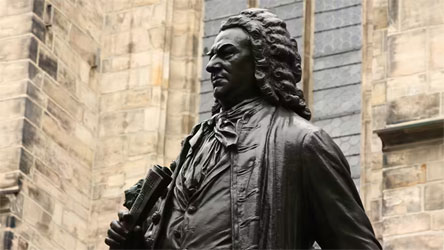“How oft it happens when one’s smoking:
The stopper’s missing on the shelf,
And one goes with one’s finger poking
Into the bowl and burns oneself.
If in the pipe such pain doth dwell,
How hot must be the pains of Hell.”JS Bach.
At some point in our education, we may have learned that the real function of the artist in society is to provide vision and leadership so as to help others enjoy, understand and be stimulated by our real and imaginary worlds – and, in turn, make it through the day. Most of the great artists of the past were held up to us as role models, their causes simplified by legend: Beethoven, the courageous individualist standing up to aristocratic abuse; Mozart, starving rather than work for a tyrannical Archbishop; and Bach, struggling on a more domestic front, enduring long hours of teaching (not to speak of bringing up) children – all for art. Misunderstanding of their art was part of their burden; Mozart and Bach were both accused of writing too many notes, Beethoven of writing incomprehensible ones. Although these three geniuses (spanning the 18th century perhaps not coincidentally) lived by their hands, as it were, their works claim our attention because of their courage of expression, the dynamism of their creative leadership, and, I shudder to use the word, the authenticity of their thought.
Johann Sebastian Bach had his role models, too – Buxtehude, for example – and from time to time he “consulted the oracle” as Richard Taruskin has aptly described the process of seeking inspiration. But how Bach regarded Buxtehude is how we might well recognize Bach: as a master, not a god; filled with delight, respect, and admiration, not worship; and stimulated to a human response, not a mindless, mechanical or methodological one. That great master would have desired us to be fired to action, not awed into obedience.
That we, performers and listeners, should take a full and active role is part of the lesson we learn from Bach’s life and work. Given the opportunity, how far did he go? In any musical endeavour Bach undertook – notably cantata, concerto, fugue, trio-sonata, chorale-Magdalena in 1725, Bach expands our modest horizons from the armchair to the very gates of infinity. He believed deeply in his religion, too, possessing a library of religious documents of great scope, and whilst we need not think that he personally believed every word he set to music, perhaps the first words of his cantata BWV 174 give us the gist of his faith and personal creed: Ich liebe den Höchsten von ganzen Gemüthe (“I love the Almighty with my entire spirit”).
Carl Philipp Emanuel recalled in 1774 that “the first thing Bach would do in trying an organ was this: he would say, in jest, ‘Above all I must know whether the organ has good lungs,’ and to find out, he would draw out every speaking stop and play in the fullest and richest possible texture. At this the organ builders would often grow quite pale with fright.” In his organ playing “No one was as happy as he in all kinds of taste and figuration, and variety of ideas in general.”
In 1796, Johann Friedrich Reichardt summed up the comprehensive quality of Bach’s art. “Never did a composer, not even the best and deepest of the Italians, exhaust all the possibilities of our harmony as did this great artist. He employed every proper harmonic art and improper harmonic artifice, in earnest and in jest, with such boldness and individuality that the greatest harmonists, if called upon to supply a single missing measure in one of his greater works, could perhaps not be sure of having supplied it exactly as Bach had done.” And even his critics, prelude, ground-bass; for harpsichord, organ, clavichord, violin, cello, viola da gamba, oboe, flute, trumpet, or horn – he exceeded ( and still exceeds) all expectations. Indeed his specialty was the exploitation of a single idea, tension or affect, and although he shared this aesthetic with artists of his day, he carried his ideas to greater dimensions. For Bach, a survey of current keyboard styles meant a four volume Klavierübung, including nothing if not the cosmic Goldberg Variations. To gather together a few preludes and fugues for teaching was not Bach’s way – what was needed did not adequately exist, so he provided it twice: twenty-four preludes and fugues in all the keys (The Well-Tempered Clavier). He was professionally successful for forty years as an organist, violinist, orchestral director, choir director, Collegium director, entrepreneur and educator; we need look only at his works and his heritage of students to know how little he flinched from courageous activity in these areas.
For a person who did not travel widely, Bach’s experience was wide and deep; his home, according to his son Carl Philipp Emanuel, was “like a beehive,” and it could be said that Bach exploited Leipzig much the way he took full advantage of anything or any place he came across. (At home, he definitely went all the way – how many of us are inspired to have twenty children?) Even in the little tobacco ditty he wrote for his wife Anna such as Johann Adolph Schreibe (1737) found Bach too large to understand: “he darkens the beauty of his works by an excess of art.” Finally, Johann Christian Kittel, in 1808, begins to suggest what Bach expected of others: “One of his most capable pupils always had to accompany on the harpsichord. It will be easily guessed that no one dared put forward a meagre thoroughbass accompaniment.”
As a father of tens, conductor of dozens, and educator of hundreds, Bach demonstrated in his work and his personal life a remarkable faith in the human spirit’s power to act: to absorb at all levels, to perform in all guises, to entertain and be entertained, and to move and be moved, to learn, grow, leave the fold, and to combine simultaneously tradition and courageous new action, loyalty and independence, taste and toleration.
To be willing to find our own creative energy in Bach’s music, we do justice not only to ourselves but to Bach. And just as Bach surmounted his difficulties to express his enormous range of thoughts, there is no reason to think that history and current practice need be in conflict.


